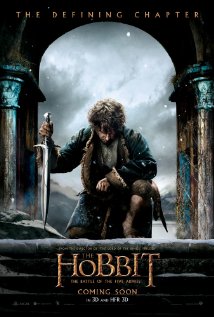Review: The Hobbit: The Battle of the Five Armies
 The greatest adventure may be what lies ahead, but The Hobbit: The Battle of the Five Armies is the end of the road for Peter Jackson's time in Middle Earth. The 13 years since the release of The Lord of the Rings: Fellowship of the Ring have seen the growth of the franchise into an international phenomenon while the digital filmmaking magic used in its creation has become commonplace in the industry, expanded and improved.
The greatest adventure may be what lies ahead, but The Hobbit: The Battle of the Five Armies is the end of the road for Peter Jackson's time in Middle Earth. The 13 years since the release of The Lord of the Rings: Fellowship of the Ring have seen the growth of the franchise into an international phenomenon while the digital filmmaking magic used in its creation has become commonplace in the industry, expanded and improved.
I was fortunate to have the chance to wait and see the presentation during the private Ain't It Cool Butt-numb-a-thon event, where it played in the HFR 48 frames per second but in 2D, not 3D projection -- the first (and perhaps only) time the film was screened for an audience with this kind of projection in the United States. While I find HFR with 3D to be headache-inducing, I quickly adjusted to the higher frame rate when it was 2D.
This third installment is appropriately named. Most of The Hobbit: The Battle of the Five Armies is concerned with events that play out as different races converge to loot the treasure under the mountain after the death of Smaug. But after the buildup over two previous films, the tumultous battle with the dragon, the climax of J.R.R. Tolkien's novel becomes merely an opening sequence here to set the stage for events that don't make much logical sense.
Thorin, leader of the company of dwarves, has found himself returned to his home inside the mountain and sitting atop a pile of gold ... and suddenly loses his sense of right and wrong, succumbing to a mysterious "dragon sickness" within the span of about 5 minutes it takes Smaug to fly out of the mountain and start burning everything in sight. His sudden onset of avarice leads him, like a drug addict, to break his promises, alienate his friends, and cost him that which he holds most dear. Meanwhile, the orcs who have been chasing the company throughout the three films are converging on the mountain with an overwhelming force.
Most of this action never takes place in Tolkein's The Hobbit, but is alluded to in other Tolkein materials. For example, a confrontation between Gandalf, Saruman, Galadriel, Radagast, and Elrond against the shade of Sauron does not drive the plot of the film and also serves to negate much of the first half of The Fellowship of the Ring. As much as I like seeing these scenes play out, and knowing they could never merit their own movie, they unfortunately still weaken this film, saddling it with an uneven plot, which fails to flow as well as any of the three films in Jackson's Lord of the Rings trilogy.
That is not to say I didn't enjoy greatly watching The Hobbit: The Battle of the Five Armies. Jackson has crafted an emotional flow to the plot that works despite the logical failures. It's the most visually stunning of the six films, with action sequences and fight choreography surpassing anything previously seen in the Tolkien adaptations. On every level it is a technical achievement, except the execution of the story. For holiday moviegoers, it's an emotional goodbye to characters and places we've grown to love.

